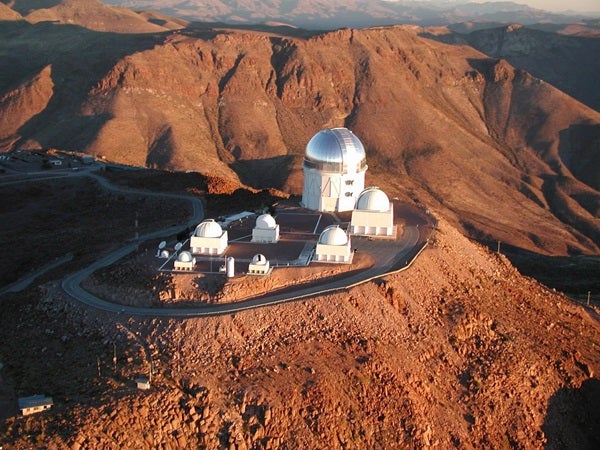UK astronomers, as part of an international team, have reached a milestone in the construction of one of the largest ever cameras to detect the mysterious dark energy component of the universe. The pieces of glass for the five unique lenses of the camera have been shipped from the United States to France to be shaped and polished into their final form. The largest of the five lenses is one meter in diameter, making it one of the largest in the world.
Each milestone in the completion of this sophisticated camera brings us closer to detecting the mysterious and invisible matter that cosmologists estimate makes up around three quarters of our universe and is driving its accelerating expansion. Observations suggest that roughly 4 percent of the universe is made up from ordinary matter and 22 percent from dark matter; this leaves 74 percent unaccounted for — the so-called dark energy.
The Dark Energy Survey (DES) camera will map 300 million galaxies using the Blanco 4-meter telescope — a large telescope with new advanced optics at Chile’s Cerro Tololo Inter-American Observatory.
The vast DES galaxy map will enable the astronomers to measure the dark energy far more precisely than current observations. Ofer Lahav, head of the UCL Astrophysics Group, who also leads the UK DES Consortium, comments “Dark energy is one of the biggest puzzles in the whole of physics, going back to a concept proposed by Einstein 90 years ago. The DES observations will tell us if Einstein was right or if we need a major shift in our understanding of the universe.”
The glass for the five lenses was manufactured in the United States before being shipped to France where the lenses will be polished to a smoothness level of one-millionth of a centimeter.
Peter Doel of the Optical Science Laboratory at UCL says, “The polishing and assembly of the five DES lenses will be a major technological achievement, producing one of the largest cameras on Earth.”
This level of polishing across such large lenses is far more demanding than for normal eyeglasses. The lenses will then be sent to the Optical Science Laboratory at UCL in London for assembly into the camera and from there to the telescope in Chile, where observations will start in 2011 and will continue until 2016.
The Science and Technology Facilities Council is providing support for the DES collaboration, which involves over 100 scientists from the US, UK, Spain and Brazil. The UK consortium includes members from UCL (University College London), Portsmouth, Cambridge, Edinburgh and Sussex universities.
The latest milestone was announced by astronomers from UCL and the US Fermilab National Accelerator Laboratory at a conference on optical instrumentation held at Marseille France, on 23 June 2008.
“The DES Team is thrilled that this long and technically demanding step in the construction of the camera has begun and we congratulate the STFC for making it possible to meet this milestone on schedule,” says the DES Director, John Peoples of Fermilab.
John Womersley, the Director of Programs at STFC, adds, “We are delighted that the UK is taking an important role in this innovative project which will help us understand one of the deepest mysteries of the universe.”










